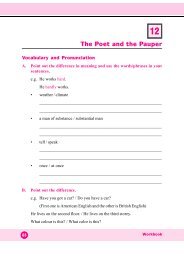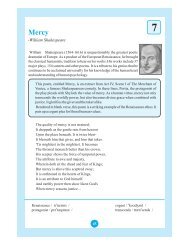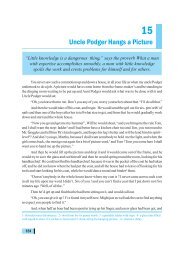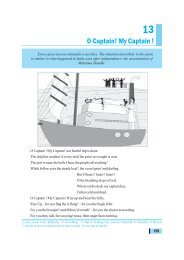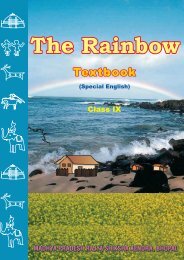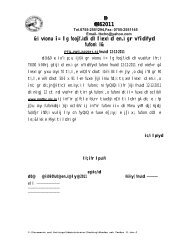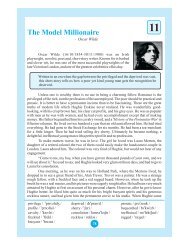PRONUNCIATION
PRONUNCIATION
PRONUNCIATION
You also want an ePaper? Increase the reach of your titles
YUMPU automatically turns print PDFs into web optimized ePapers that Google loves.
<strong>PRONUNCIATION</strong><br />
No doubt, you can certainly read and write English. Here is an attempt to help<br />
you to pronounce English better than you do now. Generally English is not<br />
spoken as it is written. Language is primarily spoken. Instead of giving you all<br />
theory of English speech, our efforts are to highlight certain important features of<br />
speech. This may enable you to understand some basics of English speech. It will<br />
also help you to consult an English pronouncing dictionary in case of doubt about<br />
the pronunciation of a word.<br />
Every language has a different number of systems. These system operate at<br />
different levels. With hard work or practice it is easy to have good English pronunciation.<br />
English has 26 letters but 46 phonemes (i.e. meaningful or basic sounds).<br />
Phonemes help us to keep each word or longer utterance separate from every<br />
other. First, you must be able to produce 46 phonemes, i.e. 22 vowels and 24<br />
consonants. Secondly in learning pronunciation you must learn to use as many<br />
different sounds as is necessary to represent a particular phoneme. In words like<br />
‘DAY’ and ‘THEY’ initial sounds are different. In some other languages then may<br />
be the same. Therefore, one must try to forget the habits of one's language and use<br />
the sounds independently as in English. It all depends on a great deal of practice.<br />
In English ‘PEN’ and ‘PIN’ are pronounced differently and their meanings<br />
are also different. The difference between the vowel sounds make a difference in<br />
meaning. The sounds /p/ and /n/ are the same in both the words. The words ‘PUT’<br />
and ‘CUT’ are not pronounced alike. Again the vowel sounds in these two words<br />
are different, As for as vowel sounds are concerned, we can say ‘PUT’ is like<br />
‘GOOD’ and ‘CUT’ is like but, shut, etc. In words like ‘GOOD’ and ‘FOOD’ we<br />
have double O in the spellings but the pronunciation of both these words is different.<br />
In words like 'SON' and 'SUN' spellings are different but the pronunciation of<br />
both the words is similar.<br />
144 WORK BOOK
Now try to learn some essential basic theoridical aspects of speech. They<br />
are elementary but essential for practice.<br />
i. Speech Theory : What happens when me speak?<br />
ii. We may make it vibrate by using the vocal cords.<br />
iii. We make changes in the sound by changing the position of the tongue, lips,<br />
teeth etc.<br />
Practical :<br />
WORK BOOK<br />
What happens when we speak?<br />
i. Put your hand on your throat. Breathe out slowly (mouth open), making no<br />
noise. Did your throat, vibrate? No. Now breathe out slowly, saying ‘a-aah’.<br />
Did your throat vibrate? Yes. This vibration was made by the vocal<br />
cords.<br />
ii. Say 'a-a-ah' with mouth wide open. Now dose the lips, leaving a small<br />
round hole only. Try to say 'a-a-ah'. Is this sound the same as the first one?<br />
No. How was the sound changed? By closing the lips. We make different<br />
sounds by changing the position of the speech organs.<br />
How many different sounds do we need to make?<br />
Some languages use more 'basic sounds' than others. Each language has its<br />
own set of ‘basic sounds’. When we learn our mother tongue we train ourselves to<br />
hear the difference between these basic sounds. This is necessary, because changing<br />
a basic sound changes the meaning. Another word for a 'basic sound' is a<br />
'Phoneme'.<br />
What link in there between spoken English and written English?<br />
Written English tries to record the English we speak. It does not do this<br />
very well, because English has 46 sounds but only 26 letters to write them with. So,<br />
some sounds are written sometimes in one way, sometimes in another. And there<br />
are letters which sometimes stand for one sound, and sometimes for another.<br />
145
Practical :<br />
i. The following words have three letters. How many sounds are there in each<br />
word?<br />
can, cap, cat, man, mat, map, tin, pin, sit, hit<br />
ii. All these words have four letters. How many sounds are there in each<br />
word?<br />
stop, spin, step, spot, skip, plan, plot, flag, trip, clap<br />
iii. All these words have four letters. How many sounds are there in each<br />
word?<br />
shop ship shed wash rich chin chop<br />
such thin with this path fall bell<br />
pass miss shoe show know more<br />
iv. All these words contain the letter 'a'. They are arranged in groups of five. In<br />
each group there are four words in which the letter 'a' represents the same<br />
sound. One word in each group has a letter 'a' which does not represent the<br />
same sound as the rest : which?<br />
(1) cap flat matter make trap<br />
(2) start farm half stay car<br />
(3) match march part star calm<br />
(4) along among fireman about apple<br />
(5) plane plan bake tame may<br />
Therefore, in written English some letters may stand for more<br />
than one sound, and some sounds may be represented in more<br />
than one letter.<br />
146 WORK BOOK
(2) English Vowels<br />
WORK BOOK<br />
What is a vowel sound?<br />
A vowel sound is one made with the vocal cards vibrating, but in which we<br />
cannot hear the sound of friction between speech organs (i.e. hissing, buzzing or<br />
explosions)<br />
Practical<br />
(i) Say the sound /i:/as in 'meet'. Any hisses, buzzes, bangs? No. This<br />
is a vowel sound.<br />
(2) Say the sound 'b, b, b'/b/. Any hisses, buzzes, bangs? Yes. There<br />
is a bang. This is not a vowel sound.<br />
(3) Say the sound ' s-s-s'/s/ as in 'See'. Any hisses, buzzes, bangs? Yes<br />
- a hiss. This is not a vowel sound.<br />
What kinds of vowel sounds are there?<br />
(a) First there is the pure vowel sound. Here the sound remains the<br />
same from start to finish.<br />
(b) Then there is the diphthong sound. This is a combination of<br />
two vowel sounds in which the voice moves quickly from one<br />
sound to the other.<br />
(i) Say the words 'get', 'wet', 'yet'. Do the sounds underlined remain<br />
the same from start' to finish? Yes. They are pure vowels.<br />
(ii) Say the words 'gate', 'wait', 'late'. Do the sounds understand remain<br />
the same from start to finish? No. They are two vowel sounds<br />
combined. They are diphthongs.<br />
(iii) In the list below are pairs of words. Which of the pair has a pure<br />
vowel, which has a diphthong?<br />
147
hand - hide pain - pen<br />
hat - hate still - style<br />
site - sat note - not<br />
gate - get come - comb<br />
ball - boy say - see<br />
main - men down - done<br />
ought - out feet - fear<br />
How many English vowel sounds are there?<br />
(a) There are 12 pure vowel sounds.<br />
(b) Ther are 8 diphthong sounds.<br />
How many English vowel letters are there?<br />
Only 5 - a, e, i, o , u.<br />
(Sometimes the letters y, w, and r are also used in writing vowel sounds)<br />
How can we write 20 vowel sounds with only 5 (+3) vowel letters?<br />
We find it very hard. We try to do it in many different ways, but this can be<br />
confusing e.g. met - / met /<br />
meat - /mi:t/<br />
meet - /mi:t/<br />
mete - /mi:t/<br />
The three words : meat, meet, mete, all sound the same, but they are spelt in<br />
different ways.<br />
Therefore, when talking about sounds, the best way is to use a special kind<br />
of writing in which one letter (symbol) stands for one sound. This kind of writing is<br />
called phonemic script.<br />
148 WORK BOOK
Phonemic script<br />
1. We put phonemic script inside slanting lines ‘/ /’ to show that it is not<br />
ordinary spelling.<br />
2. We do not use capital letters.<br />
3. It is not ................<br />
(ii) These are the pure vowel symbols :<br />
Practical<br />
WORK BOOK<br />
/i:/ as in SEAT /si:t/<br />
/I/ as in SIT /sIt/<br />
/i/ as in HAPPY /'h&pi/<br />
/e/ as in SET /set/<br />
/&/ as in SAT /s&t/<br />
/A:/ as m FARM /fA:m/<br />
/Q/ as in SHOT /shQt/<br />
/O:/ as in SORT /sO:t/<br />
/U/ as in FOOT /fUt/<br />
/u:/ as in SHOOT /SU;t/<br />
/u/ as in ACTUAL /'&ktSuJl/<br />
/V/ as in SHUT /SVt/<br />
/3:/ as in SHIRT /S3;t/<br />
/J/ as in UPON /J'pQn/<br />
i. Read the following words, which are written in phonemic script.<br />
/i:/ /mi:/ /si:t/ /hi:t/ /ri:d/ /wi:k/<br />
/I/ /It/ /sIt/ /tIn/ /hIm/ /hil/<br />
149
i/ /'n&pi/ /'s&pi/ /'flQpi/ /'kQpi/ /'slQpi/<br />
/e/ /bed/ /men /red/ /send/ /rek/<br />
/&/ /m&n/ /k&t/ /s&t/ /p&k/ /l&nd/<br />
/A:/ /pA:t/ /hA:d/ /stA:/ /fA:m/ /kA:/<br />
/Q/ /tQp/ /hQt/ /lQt/ /kQst/ /stQp/<br />
/O;/ /tO;l/ /bO;t/ /brO;t/ /kO;n/ /bO;d/<br />
/U/ /fUt/ /pUt/ /hUk/ /kUk/ /pUl/<br />
/U:/ /tU:/ /hU:/ /mU:n/ /rU:d/ /lU:s/<br />
/u/ /'f&ktSuJl/ /'v3;tSuJl/ /'gr&dZuJl/ /'mju;tSuJl/ /'rItSuJl/<br />
/V/ /hVt/ /dVn/ /sVn/ /dVl/ /bVs/<br />
/3;/ /b3;d/ /b3;n/ /w3;k/ /g3;l/ /st3;/<br />
/J/ 'fA;mJ(r) /'fItJ(r)/ /'dO;tJ(r)/ /J'pQn/ /J'gri;/<br />
ii. Which words do not contain the sound written at the left.<br />
/i:/ seed eat bread case<br />
/e/ here head men friend<br />
/A:/ car care half pass<br />
/Q/ on lot lost one<br />
/U/ pull cook spoon full<br />
/V/ tub cut come luck<br />
/J/ father mother away apple<br />
150 WORK BOOK
Phonemic script : Diphthongs<br />
i. Because these combine two sounds, each diphthong symbol contains two<br />
letters.<br />
ii. These are the diphthong symbols:<br />
Practical<br />
WORK BOOK<br />
/eI/ as in say /seI/<br />
/aI/ as in fly /flaI/<br />
/OI/ as in boy /bOI/<br />
/aU/ as in how /haU/<br />
/oU/ as in no /noU/<br />
/IJ/ as in here /hIJ(r)/<br />
/eJ/ as in hair /heJ(r)/<br />
/UJ/ as in poor /pUJ(r)/<br />
Read the following words, which are written in phonemic script :<br />
/eI/ /meI/ /keIm/ /leIt/ /meIl/ /beIk/<br />
/aI/ /maI/ /taIm/ /laIt/ /saIn/ /waIl/<br />
/OI/ /bOI/ /bOIl/ /kOIn/ /tOI/ /OIl/<br />
/aU/ /haU/ /kaU/ /taUn/ /aUt/ /laUd/<br />
/oU/ /soU/ /noU/ /boUt/ /koUt/ /oUn/<br />
/IJ/ /tIJ/ /bIJd/ /fIJ/ /dIJ/ /hIJ/<br />
/eJ/ /reJ/ /beJ/ /deJ/ /heJ/ /peJz/<br />
/UJ/ /pUJ/ /dUJ/ /tUJ/ /trUJ/ /blUJ/<br />
151
What is a consonant sound?<br />
A consonant sound is one in which we can hear the sound of friction<br />
between speech organs. Some are hissing voices, like the /s/ in SEA. Some are<br />
buzzing noises, like the /z/ in zoo'. Some are explosions, like the /P/ in 'PAN'.<br />
There are other kinds of consonant noises, too.<br />
Practical<br />
(1) Say the words 'SHEEP'<br />
Which is the vowel sound? ............... /i:/<br />
Which is the first consonant sound? ......... the sound written 'sh' /S/<br />
Is the sound /P/ a vowel or a consonant? ......... A consonant.<br />
(2) Say the word 'SICK'<br />
Now say the word 'SILK'<br />
Are they the same? ........... No<br />
How many consonant sounds are there in 'SICK'? ....... Two /s/ and /k/.<br />
How many in 'SILK' .......... Three ........./s/, /l/, /k/<br />
How many English consonant sounds are there? ........24<br />
How do we write them in phonemic script?<br />
Some are written and pronounced in the same way as we usually<br />
write and pronounce them in ordinary writing :<br />
/b/ as in bed rub<br />
/d/ as in dog bad<br />
/f/ as in fan half<br />
/g/ as in get dog<br />
/h/ as in hat hat<br />
152 WORK BOOK
WORK BOOK<br />
/k/ as in king walk<br />
/l/ as in lamp girl<br />
/m/ as in man seem<br />
/n/ as in not man<br />
/p/ as in pen top<br />
/r/ as in run fairy<br />
/s/ as in sit bus<br />
/t/ as in time hat<br />
/v/ as in very love<br />
/w/ as in wet -<br />
/z/ as in zoo -<br />
There are 8 others for which we use special symbols :<br />
/S/ as in sheep wash<br />
/tS/ as in church catch<br />
/dZ/ as in judge germ<br />
/N/ as in sing having<br />
/T/ as is thick path<br />
/D/ as is this bathe<br />
/j/ as is yet year<br />
/Z/ as is pleasure usual<br />
153
Practical<br />
Which English consonant letters are not used in English phonemic script<br />
e - - x - - q - - y<br />
Now read the following words, which contain the sound written at the left :<br />
/S/ /Sip/ /Sed/ /Seik/ /wiS/ /diS/<br />
/tS/ /tSip/ /tSQp/ /tSein/ /ritS/ /pitS/<br />
/dZ/ /dZO;/ /dZVdZ/ /dZOI/ /rIdZ/ /keIdZ/<br />
/N/ /siN/ /wiN/ /lQN/ /sQN/ /b&N/<br />
/T/ /Tik/ /Tin/ /Tri:/ /pa:T/ /TO:t/<br />
/D/ /Den/ /Dis/ /D&t/ /wiD/ /beiD/<br />
/j/ /jU:/ /jes/ /jet/ /jel/ /jU:s/<br />
/Z/ /'treZJ/ /'pleZJ/ /'meZJ/<br />
Read these words which are written in phonemic script :<br />
/set/ /get/ /jet/ /det/ /met/<br />
/wQt/ /wQtS/ /wQS/ /wQz/ /wQnt/<br />
/sin/ /siN/ /s&N/ /sQN/ /sVN/<br />
/wiT/ /wID/ /Di:z/ /DoUZ/ /ri:T/<br />
/hedZ/ /b&dZ/ /rIdZ/ /wedZ/ /peIdZ/<br />
154 WORK BOOK
Revision<br />
i. What use in phonemic script? It helps us to write sounds properly.<br />
ii. All the words below have the letter 'S' underlined. They are written in ordinary<br />
English. In each one the 'S' is pronounced in a defferent way. How<br />
would you write these 'S' sounds in phonemic script?<br />
WORK BOOK<br />
rose /z/<br />
post /s/<br />
usual /Z/<br />
iii. Is there any defference between the sounds underlined in the words below?<br />
Stress<br />
ration, sharp, mission<br />
How would you write the sound underlined? /S/<br />
What do you mean by 'STRESS'<br />
When a man plays the 'table' he sometimes luts it harder, sometimes softer.<br />
When we speak English we 'hit' some sounds harder and some sounds softer.<br />
Practice<br />
(a) Look at the pattern below :<br />
l - - l - - l - -l - -l - -l - -<br />
(b) At each l tap the table (desk/floor/book) hard; at each _ tap the table softly.<br />
Repeat this four times.<br />
(c) Now say the word 'beautiful' six times, tapping hard for 'beau - - and softly<br />
for --- ti --- ful<br />
NOW, look at this pattern :<br />
(a) l - l - l - l - l - l<br />
155
(b) Tap this pattern four times : (1 means hard - means softly)<br />
(c) Now say ' former six times, tapping hard for ' ta - - , and softly for - - -<br />
their.<br />
Eevery word with more than one syllable has atleast one hard<br />
(strong) beat (there are very few exceptions).<br />
(a) Sometimes the strong beat (strong stress) is on the first syllable :<br />
'father, 'mother 'talking 'cheapest<br />
(b) Sometimes the strong stress is on the second syllable :<br />
a'way, re'turn, in'form, de'cide<br />
(c) We mark strong stress with the sign 'before the strongly stressed syllable.<br />
(d) Syllables which are not stressed often contain the vowel /J/ and this vowel<br />
occurs in unstressed syllables never in stressed ones. But it is not true to<br />
say that /J/ is the only vowel which occurs in unstressed syllables, all the<br />
other vowels can occur there too and /i/ is commonly found there, the<br />
remaining vowels less commonly so.<br />
obtain, invent, allow, adore, account<br />
(e) What is a syllable? A word or part of a word which contains a vowel sound<br />
or a consonant acting as a vowel. e.g. there are two syllables in 'WIN-<br />
DOW' - 'win' - and' - dow'<br />
Practical<br />
(1) All the words below have two syllables, and the first syllable of each<br />
is strongly stressed. Say them :<br />
'father 'mother 'sister 'brother<br />
'talking 'running 'sitting 'jumping<br />
'waited 'posted 'painted 'started<br />
'hopeful 'helpless 'cheerless 'careless<br />
156 WORK BOOK
(2) All the words below have two syllables, the second of which is strongly<br />
stressed. Say them :<br />
WORK BOOK<br />
a'way a'bout a'long a'cross<br />
re'turn re'fuse re'pay re'ject<br />
de'tain de'part de'lay de'mand<br />
in'tend in'ject in'fect in'spect<br />
con'fuse con'firm con'duct con'tain<br />
(3) In sentences some syllables are strongly stressed :<br />
Practical<br />
(A) ' What do you 'want?<br />
(B) ' How do you 'do?<br />
(i) Which words in 3A are strongly stressed?<br />
(ii) Say the sentence several times, putting strong stress on the words marked.<br />
(iii) Which words in 3B are strongly stressed?<br />
(iv) Say the sentence several times, putting strong stress on the words marked.<br />
(v) Notice that the sentences 3A and 3B above have the same stress pattern.<br />
strong weak weak strong<br />
What do you want?<br />
How do you do?<br />
(vi) we can write this pattern :<br />
1 - - 1<br />
These sentences have the same pattern, 1 - - 1 . Say them<br />
157
Where did he go?<br />
What did she do?<br />
How did he come?<br />
Why did you stop?<br />
When will they know?<br />
Put it away.<br />
Give him a sweet.<br />
Show me your book.<br />
Pick up your pen.<br />
Look at the Sky.<br />
Now, make as many sentences as you can with the pattern 1 - - 1 i.e. strong, weak,<br />
weak, strong.<br />
_____________________________________________________________<br />
_____________________________________________________________<br />
_____________________________________________________________<br />
_____________________________________________________________<br />
_____________________________________________________________<br />
_____________________________________________________________<br />
_____________________________________________________________<br />
_____________________________________________________________<br />
_____________________________________________________________<br />
_____________________________________________________________<br />
R<br />
158 WORK BOOK



